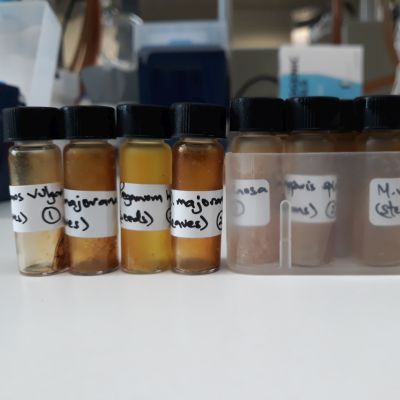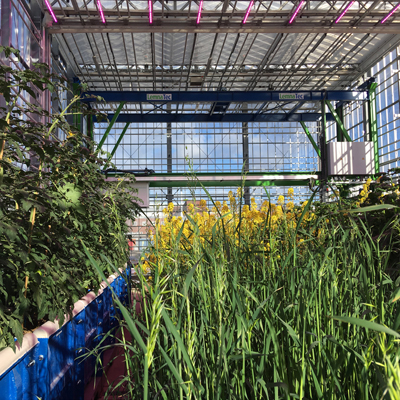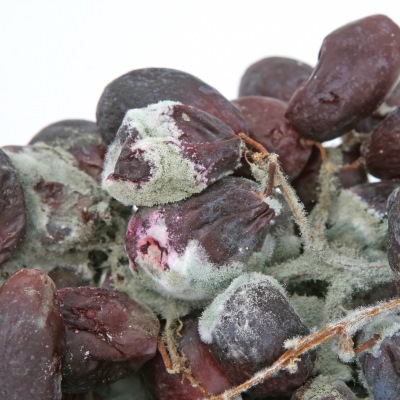Areas of expertise
- Applied Informatics
- Bioinformatics
- Food Quality
Background
Dr Maria Anastasiadi graduated from the University of Crete with a degree in Chemistry. She then studied for an MSc in Food Science and Technology at the Agricultural University of Athens and later obtained a PhD in Plant Science and Analytical Chemistry from the same institute.
She has also completed a PGCert in Statistics at the University of Sheffield and a sponsored MSc in Applied Bioinformatics at Cranfield University.
Current activities
Dr Maria Anastasiadi is Senior Lecturer in Bioinformatics with an extensive background in Plant and Food Science and Metabolomics. Maria's skill set includes both wet and dry lab techniques such as Mass Spectrometry, Spectroscopy, NGS, Machine Learning and Artificial Intelligence. Maria's research is focused on promoting sustainability across the food supply chain and enhance health promoting properties of food products. She is applying multi-omics to study how factors such as climate change, pre-harvest and post-harvest practices affect horticultural crop quality and nutritional value, and she has explored innovative postharvest solutions to extend storage life of UK crops. She is also seeking to optimise nutrient bioavailability, by acquiring experimental data and developing prediction models for different food matrices.
Maria is combining sensor technology and Machine Learning to create rapid non-invasive methods for monitoring food safety, quality and integrity at all stages of the supply chain to ensure traceability and minimise food waste and risks to human and animal health. She has developed spectroscopic methods for honey authentication and adulteration detection using Fluorescence and Spatially Offset Raman Spectroscopy. She is also developing methods for the use of electrochemical sensors and Enhanced Surface Raman Spectroscopy for the detection of contaminants pesticides and heavy metals in African honey.
Furthermore, she is looking to develop more sustainable agricultural practices by developing novel biostimulants and bioprotectants and developing automated solutions for insect pollinator monitoring to inform future environmental policies.
Projects Maria is currently working on include:
"Establishing a rapid testing system for contaminant detection in African honey as means of quality control and environmental monitoring". (co-I). The aim of this project is to establish sensor-based methods employable in field for the detection and quantification of contaminants in African honey, such as pesticides and heavy metals.
Sponsors: STFC Food Network+ (SFN), AAKTP
"Monitoring tropical pollinators in conventional and organic fruit orchards in central Thailand". (co-I). This project is seeking to investigate the effect of pesticide use on native pollinators in South East Asia by combining analytical laboratory techniques and deep learning.
Sponsors: STFC Food Network+ (SFN)
"Honey authentication using intrinsic DNA markers and metabolic fingerprint". (PI). The aim of this project is to develop a machine learning application for the authentication of premium monofloral honeys based on unique chemical and DNA biomarkers.
Sponsors: UKRI-BBSRC FoodBioSystems Doctoral Training Partnership.
"A decision-support system for optimising nutrients bioavailability from food matrices using Artificial Intelligence (AI) and Machine Learning (ML)". (PI). The aim of this project is the development of an application for the prediction of the bioavailability of (micro)nutrients such as Vitamin E, Vitamin D, lipids and starch in different food matrices.
Sponsors: Cranfield University and Université de Technologie de Compiègne (UTC).
"Agricultural Bioproducts from Medicinal and Aromatic Plants". (PI). The aim of this project is the discovery of novel biostimulants and bioprotectants from African medicinal and aromatic plants as alternatives to chemical pesticides and fertilisers. PI
Sponsors: OCP Group.
"Evaluating epigenetic and transcriptomic adaptations to climate change in Brasicca napus (oilseed rape)". (co-I). The aim of this project is to provide a systems-level molecular and metabolic understanding of the impact of heat stress on yield and seed development of B.napus for UK-specific varieties.
Sponsors: UKRI-BBSRC FoodBioSystems Doctoral Training Partnership.
Clients
FSA
AAKTP
Unilever
Cobrey Farms
BBSRC
UK Innovate
Avalon Produce Ltd,
Richard Hochfeld Ltd,
Greenyard Fresh UK Ltd
Publications
Articles In Journals
- Dodd S, Kevei Z, Karimi Z, Parmar B, Franklin D, .... (2025). Detection of sugar syrup adulteration in UK honey using DNA barcoding. Food Control, 167
- Kisiriko M, Bitchagno GTM, Noleto-Dias C, Naboulsi I, Anastasiadi M, .... (2025). The untargeted metabolomic analysis of Ammodaucus leucotrichus Coss. & Dur. seeds reveals previously undescribed polar lignans and terpenoids. Phytochemistry Letters, 65
- Anastasiadi M, Kevei Z, Dodd S, Shehata M, Karimi Z, .... (2025). Developing a new testing methodology for honey authentication. FSA Research and Evidence
- Heffer S, Anastasiadi M, Nychas G-J & Mohareb FR. (2025). Fusion vs. Isolation: evaluating the performance of multi-sensor integration for meat spoilage prediction. Foods, 14(9)
- Karimi Z, Campbell K, Kevei Z, Patriarca A, Koidis A, .... (2025). A critical review of conventional and emerging technologies for the detection of contaminants, allergens and adulterants in plant-based milk alternatives. Current Research in Food Science, 10
- Kourani M, Anastasiadi M, Hammond JP & Mohareb FR. (2025). Prolonged heat stress in Brassica napus during flowering negatively impacts yield and alters glucosinolate and sugars metabolism. Frontiers in Plant Science, 16
- Kisiriko M, Bitchagno GTM, Harflett C, Noleto-Dias C, Naboulsi I, .... (2025). Bioactivity screening of selected Moroccan medicinal and aromatic plants, and the chemical basis of the phytotoxicity of caper, Capparis spinosa L.. Industrial Crops and Products, 233
- Dodd S, Kevei Z, Karimi Z, Kumar JJS, Koidis A, .... (2025). Tracing the botanical origins of UK heather honey by relative quantification of plant DNA. npj Science of Food, 9(1)
- Aroucha E, Anastasiadi M, Collings ER, Araujo N & Terry LA. (2024). Shelf-life of green asparagus using cassava and chitosan blend coating. Brazilian Journal of Food Technology, 27
- Kisiriko M, Noleto-Dias C, Bitchagno GTM, Naboulsi I, Anastasiadi M, .... (2024). The first comprehensive chemical profiling of Vachellia gummifera (Willd.) Kyal. & Boatwr., a plant with medicinal value. Chemistry & Biodiversity, 21(6)
- de Castro Cogle K, Kubo MTK, Merlier F, Josse A, Anastasiadi M, .... (2024). Probabilistic modelling of the food matrix effects on curcuminoid’s in vitro oral bioaccessibility. Foods, 13(14)
- Shehata M, Dodd S, Mosca S, Matousek P, Parmar B, .... (2024). Application of Spatial Offset Raman Spectroscopy (SORS) and machine learning for sugar syrup adulteration detection in UK Honey. Foods, 13(15)
- Anastasiadi M, Collings ER & Terry LA. (2022). Investigating the role of abscisic acid and its catabolites on senescence processes in green asparagus under controlled atmosphere (CA) storage regimes. Postharvest Biology and Technology, 188(June)
- Kourani M, Mohareb FR, Rezwan FI, Anastasiadi M & Hammond JP. (2022). Genetic and physiological responses to heat stress in Brassica napus. Frontiers in Plant Science, 13(April)
- Kisiriko M, Anastasiadi M, Terry LA, Yasri A, Beale MH, .... (2021). Phenolics from medicinal and aromatic plants: characterisation and potential as biostimulants and bioprotectants. Molecules, 26(21)
- Anastasiadi M, Falagán N, Rossi S & Terry LA. (2020). A comprehensive study of factors affecting postharvest disorder development in celery. Postharvest Biology and Technology, 172
- Alamar MC, Anastasiadi M, Lopez-Cobollo RM, Bennett MH, Thompson AJ, .... (2020). Transcriptome and phytohormone changes associated with ethylene-induced onion bulb dormancy. Postharvest Biology and Technology, 168
- Anastasiadi M, Bragin E, Biojoux P, Ahamed A, Burgin J, .... (2020). CRAMER: A lightweight, highly customisable web-based genome browser supporting multiple visualisation instances. Bioinformatics, 36(11)
- Manthou E, Lago S-L, Dagres E, Lianou A, Tsakanikas P, .... (2020). Application of spectroscopic and multispectral imaging technologies on the assessment of ready-to-eat pineapple quality: A performance evaluation study of machine learning models generated from two commercial data analytics tools. Computers and Electronics in Agriculture, 175
- Anastasiadi M, Collings ER, Shivembe A, Qian B & Terry LA. (2019). Seasonal and temporal changes during storage affect quality attributes of green asparagus. Postharvest Biology and Technology, 159
- Anastasiadi M, Mohareb FR, Redfern SP, Berry M, Simmonds M, .... (2017). Biochemical profile of heritage and modern apple cultivars and application of machine learning methods to predict usage, age, and harvest season. Journal of Agricultural and Food Chemistry, 65(26)
- Anastasiadi M, Polizzi K & Lambert RJW. (2017). An improved model for the analysis of combined antimicrobials: a replacement for the Chou‐Talalay combination index method. Journal of Applied Microbiology, 124(1)
- Anastasiadi M & Lambert RJW. (2017). Modelling the effect of combined antimicrobials: A base model for multiple-hurdles. International Journal of Food Microbiology, 252
- Anastasiadi M, Mwangi PM, Ordaz-Ortiz JJ, Redfern SP, Berry M, .... (2016). Tissue biochemical diversity of 20 gooseberry cultivars and the effect of ethylene supplementation on postharvest life. Postharvest Biology and Technology, 117
- Anastasiadi M, Pratsinis H, Kletsas D, Skaltsounis A-L & Haroutounian SA. (2012). Grape stem extracts: Polyphenolic content and assessment of their in vitro antioxidant properties. LWT - Food Science and Technology, 48(2)
- Spanou CI, Veskoukis AS, Stagos D, Liadaki K, Aligiannis N, .... (2012). Effects of Greek legume plant extracts on xanthine oxidase, catalase and superoxide dismutase activities. Journal of Physiology and Biochemistry, 68(1)
- Chrysoula S, Veskoukis AS, Dimitrios S, Kalliopi L, Maria A, .... (2011). Effects of grape extracts on the in vitro activity of enzymes involved in oxidative stress regulation. In Vivo, 25(4)
- Anastasiadi M, Pratsinis H, Kletsas D, Skaltsounis A-L & Haroutounian SA. (2010). Bioactive non-coloured polyphenols content of grapes, wines and vinification by-products: Evaluation of the antioxidant activities of their extracts. Food Research International, 43(3)
- Anastasiadi M, Zira A, Magiatis P, Haroutounian SA, Skaltsounis AL, .... (2009). 1H NMR-Based Metabonomics for the Classification of Greek Wines According to Variety, Region, and Vintage. Comparison with HPLC Data. Journal of Agricultural and Food Chemistry, 57(23)
- Anastasiadi M, Chorianopoulos NG, Nychas G-JE & Haroutounian SA. (2009). Antilisterial Activities of Polyphenol-Rich Extracts of Grapes and Vinification Byproducts. Journal of Agricultural and Food Chemistry, 57(2)
- Anastasiadi M, Pratsinis H, Kletsas D, Papras A, Panagiotou A, .... (2008). Changes during ripening in the content of the principal bioactive polyphenols in five Greek native Vitis vinifera cultivars. Planta Medica, 74(09)
- Anastasiadi M, Chorianopoulos NG, Theotokatos SA, Nychas GJE & Haroutounian SA. (2008). Quantitation of polyphenolic content and determination of antilisterial activities of grapes and vinification byproducts. Planta Medica, 74(09)
- Anastasiadi M, Pratsinis H, Kletsas D, Theotokatos SA & Haroutounian SA. (2008). Determination and quantitative analysis of the principal polyphenolic compounds present in stem extracts of native Greek islands grape varieties-assessment of their antioxidant activity in Vitro. Planta Medica, 74(09)
- Anastasiadi M, Pratsinis H, Kletsas D, Skaltsounis AL & Haroutounian SA. (2008). Determination of biologically interesting polyphenols from grapes, wines and vinification byproducts of Greek origin-assessment of their in vitro antioxidant activity. Planta Medica, 74(09)
- Boziaris IS, Skandamis PN, Anastasiadi M & Nychas G-JE. (2007). Effect of NaCl and KCl on fate and growth/no growth interfaces of Listeria monocytogenes Scott A at different pH and nisin concentrations. Journal of Applied Microbiology, 102(3)
Conference Papers
- Kisiriko M, Sobeh M, Ward JL, Beale MH, Verheecke-Vaessen C, .... (2023). Non-polar compound profile and preliminary assessment of the antifungal activity of Foeniculum vulgare and Thymus vulgaris
- Anastasiadi M, Chorianopoulos NG, Theotokatos SA, Nychas GJE & Haroutounian SA. (2008). Quantitation of polyphenolic content and determination of antilisterial activities of grapes and vinification byproducts
- Anastasiadi M, Pratsinis H, Kletsas D, Skaltsounis AL & Haroutounian SA. (2008). Determination of biologically interesting polyphenols from grapes, wines and vinification byproducts of Greek origin-assessment of their in vitro antioxidant activity
- Anastasiadi M, Pratsinis H, Kletsas D, Theotokatos SA & Haroutounian SA. (2008). Determination and quantitative analysis of the principal polyphenolic compounds present in stem extracts of native Greek islands grape varieties-assessment of their antioxidant activity in Vitro
- Anastasiadi M, Pratsinis H, Kletsas D, Papras A, Panagiotou A, .... (2008). Changes during ripening in the content of the principal bioactive polyphenols in five Greek native Vitis vinifera cultivars







